
Call Now & Start Saving on Golf Today! 800-321-8269
February 2013
WHICH COURSES DO YOU WANT TO PLAY?
Golf Card is committed to adding new, quality courses to its nationwide network. If there is a course you would like to see accept The Golf Card, please let us know by e-mailing office@golfcard.com. We will do our best to contact these courses and enroll them. Or have the course call us at 1-800-321-8269.
TRAVEL SPOTLIGHT - Arizona's Best Holes
With canyons, desert, lakes and cacti, Arizona has an abundance of elements that make for some of the most scenic holes anywhere. And when it's February in the northeast and midwest, the holes look even better! Here are a few signature holes from Golf Card courses throughout Arizona that you might want to check out:
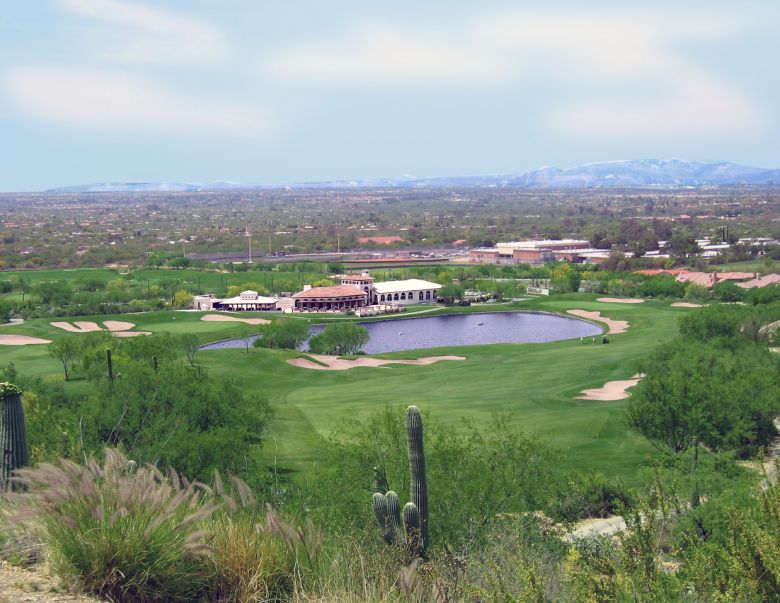
Arizona National Golf Club, No. 18:
(520-749-3636; arizonanationalgolfclub.com)
On a course full of great views, No. 18 at Arizona National is the ultimate capper. From an elevated tee,
the golfers looks down upon sweeping views of the valley floor against a backdrop of distant mountains.
The fairway bends around a lake to an angled green sandwiched between several bunkers. Located in Tucson.
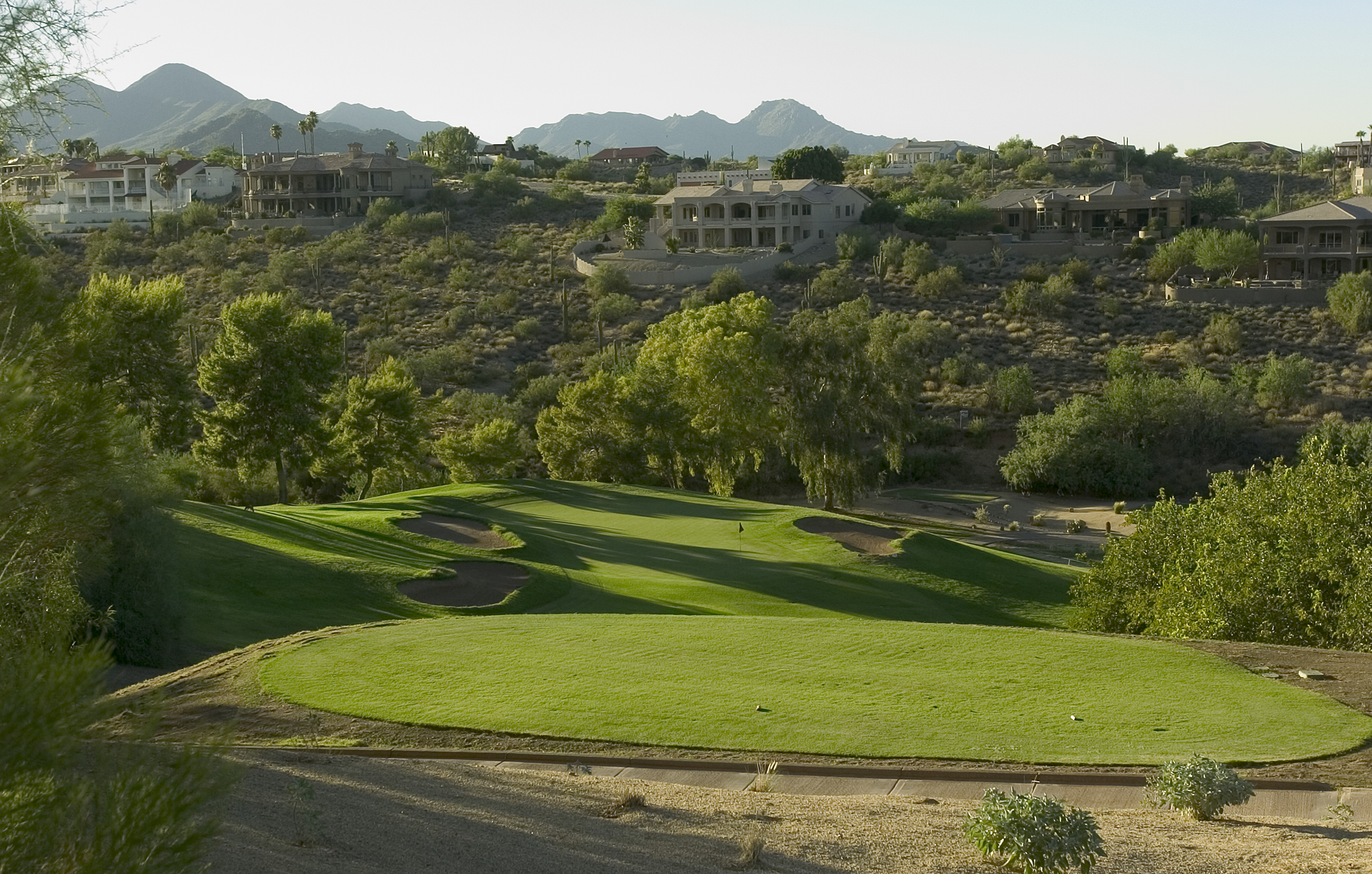
Desert Canyon Golf Club, No. 16:
(480-837-1173; desertcanyongolf.com)
A 153-foot elevation drop from tee to green defines this 152-yard par three. The green is set against a
backdrop of a rugged desert hillside. Located in Fountain Hills.
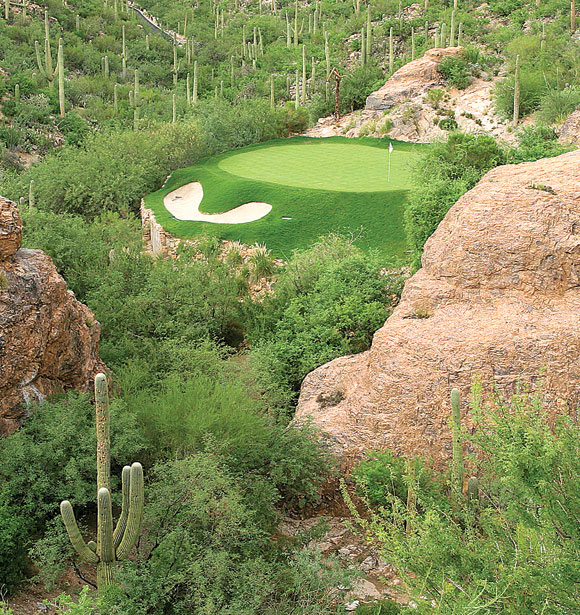
The Lodge at Ventana Canyon (Mountain Course), No. 3:
(570-577-4015; thelodgeatventanacanyon.com)
The "Hole in the Wall," as it's called, is the most dramatic desert hole of all. The short par-three is
tucked into the rugged rocks of the Santa Catalina mountains and plays across a canyon of cacti and boulders
to a two-tier green. The tee offers a breathtaking panorama that stretches across the Sonoran Desert into Mexico. Located in Tucson.

The Lodge at Ventana Canyon (Canyon Course), No. 13:
(570-577-4015; thelodgeatventanacanyon.com)
Another par-three beauty on the Ventana Canyon property, this 140-yarder descends from an elevated tee over
desert foliage to an angled green that sits on a ledge, dropping off to a series of bunkers. Located in Tucson.
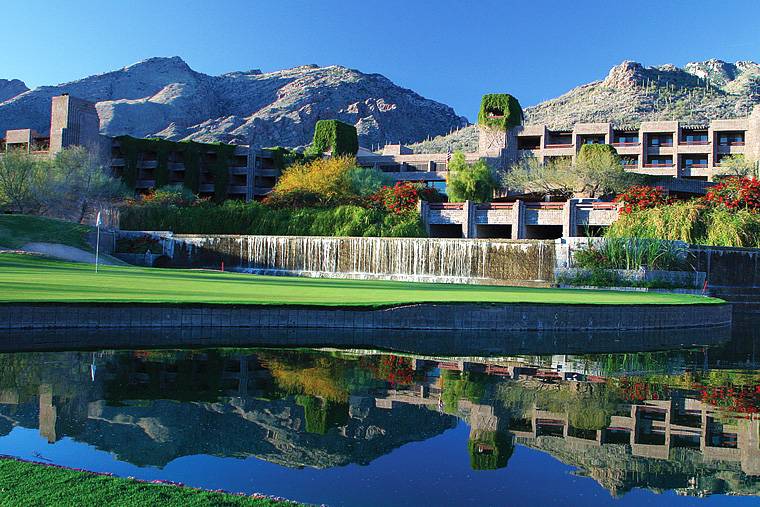
The Lodge at Ventana Canyon (Canyon Course), No. 18:
(570-577-4015; thelodgeatventanacanyon.com)
A 503-yard par five that includes a desert wash just in front of the green, making it a partial island with pond
and cascading waterfall in the rear. Located in Tucson.

Palm Valley Golf Club, No. 13:
(623-935-2500; palmvalleygolf.com)
Long par three that plays over desert to a diagonal green. Located in Goodyear.
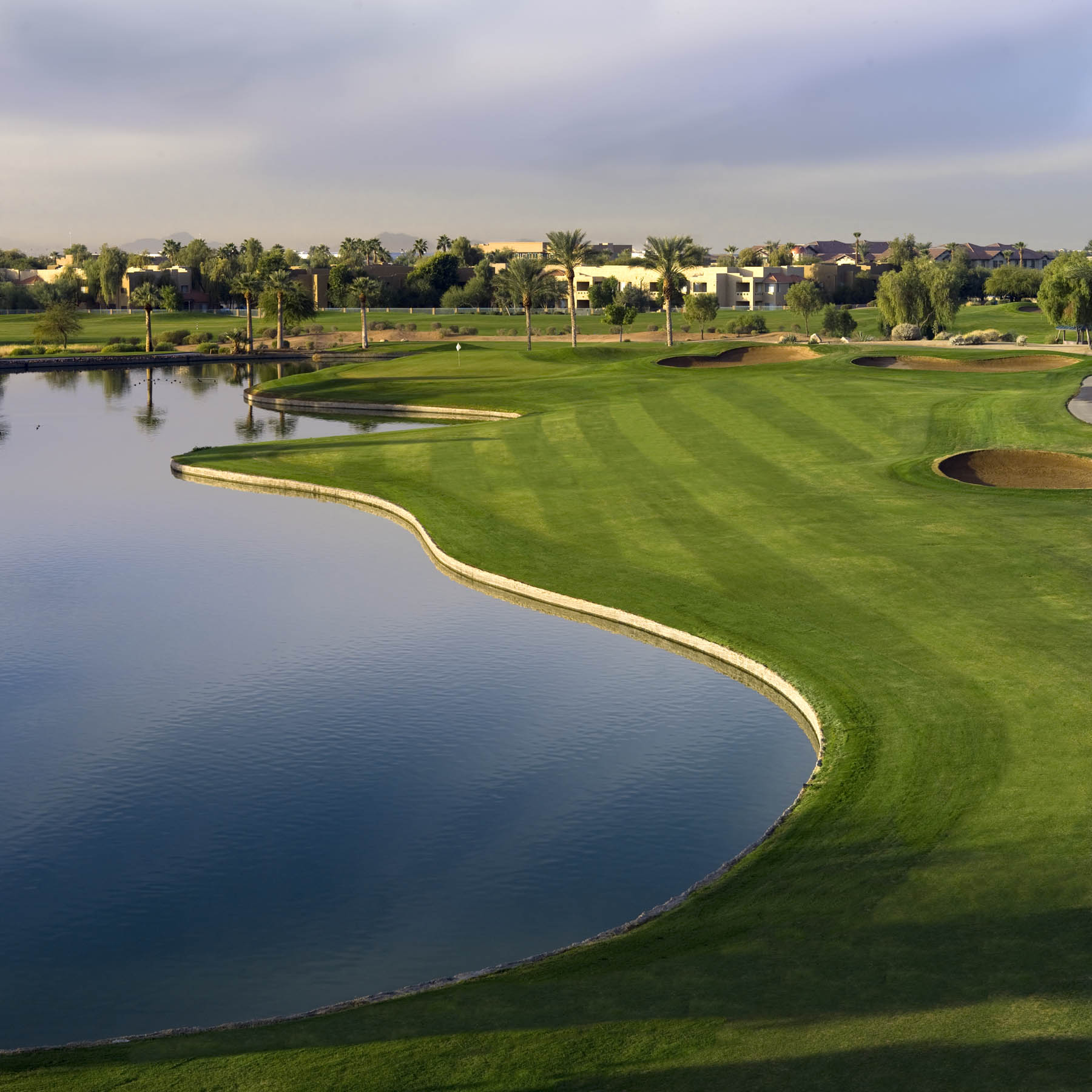
Palm Valley Golf Club, No. 18:
(623-935-2500; palmvalleygolf.com)
One of the finest closing holes in the region, this picturesque par five features a lake on the
left side of the fairway that wraps around a three-tiered green. Located in Goodyear.
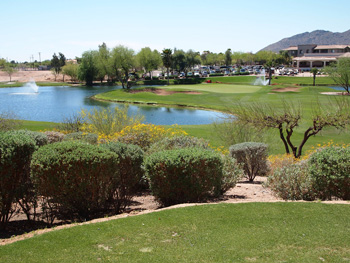
Scottsdale Silverado Golf Course, No. 18:
(480-778-0100; scottsdalesilveradogolfclub.com)
A 157-yard par three with an elevated teeing area that allows for a great view of the hole with the picturesque
Mummy Mountains serving as the backdrop. Surrounded by water and four well-positioned bunkers, this is one of the
top finishing holes in the entire Valley. Located in Scottsdale.

Tonto Verde Golf Club (Ranch), No. 15:
(480-471-2710; tontoverde.com)
The signature hole for the Ranch Course is a tough but fun par three with water surrounding the entire right side
of the green, which slopes toward the water. Bunkers also hug the right side of the green. Located in Rio Verde.
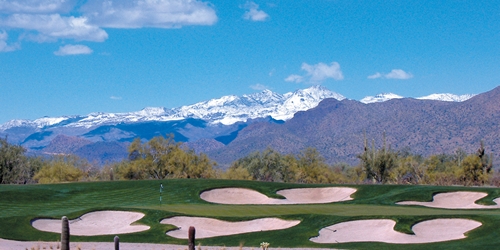
Vista Verde Golf Club, No. 4:
(480-471-2710; theverdes.com)
A 118-yard par three wedged between imposing bunkers front and back and set against snow-capped mountains in
the background. Located in Rio Verde.
Free Tee
Want to add some intrigue to your regular game, try this little extra employed by some members at an upstate New York club: whoever has the honor on the last hole can play whatever tee they want. That could be the forward tee, the back tee, the middle tee -- any tee that's built! You'd be surprised how much strategy this brings into play, especially when you factor in handicap strokes, who drives the ball what distance and what potential wagers could be riding on the last hole.
What it all means is that the 17th hole is very important to win!
JUST SAYIN' - Ken Cohen
Nike now has almost $50 million per year tied up in endorsement deals with Rory McIlroy and Tiger Woods. Which begs the question are they worth it? Sure they are the number one and two players in the world but Titleist is the number one selling ball and TaylorMade the number one driver. Even in footwear, Nike's bread and butter, Foot-Joy is tops.
To be honest, I have never bought a golf product because someone on the PGA Tour used or wore it. It's just not that type of game. First of all the perception (and the reality in many cases) is that the tour players are using different clubs than what's available to the public. Secondly, and more importantly, I buy equipment, apparel, gloves, etc. based on what looks, feels and works best for me. The truth is there are so many quality products available today that it's hard to say one manufacturer's stuff is better than another's. They're all essentially working with the same technology and within the same restrictions imposed by the USGA. And even if some company does come up with something innovative, it's just a matter of months before the other companies are able to produce something similar. The PGA Tour's slogan is "These Guys Are Good." Though it refers to the players, it could equally describe all the manufacturers.
PGA Tour players switch equipment so frequently these days, you don't even know who's playing what. Quick, can you tell me what driver Bill Haas or Keegan Bradley plays? Or what ball Hunter Mahan or Jim Furyk uses? In a way, Nike is smart to try and lock up the world's best players to long-term contracts so the public immediately knows they're Nike guys. But that's risky business also -- if those elite players struggle or fall from grace (as Tiger did), then the connection between the pubic and brand is not all that positive.
The strategy employed by Titleist and Taylor Made is to rack up numbers -- get as many players using your product and then boast that you're number one on tour. Not only does this carry a more penetrating message, it also protects these companies should a player or two or three decide to switch allegiances the following year. They still have a stable of players to fall back on as well as the free agents they pick up every year.
Many golfers buy their products simply by what's available in their local pro shops. That's where a club professional plays an integral role in impacting sales. If he's stocking just Cobra and Taylor Made, it's much more likely that his members will buy those brands. That's why some companies spend more time and money trying to win over club professionals then touring professionals.
But again, in the final analysis, it really shouldn't matter to you if McIlroy is playing Nike or Bubba Watson Ping. Buying golf gear must come down to personal preference. You might find that a Taylor Made driver, Callaway irons, Cleveland wedge, Titleist ball and Nike shoes are the best choices for you. That's why brand loyalty in golf must be tempered and why huge endorsement deals are not always great investments. Sure they build brand awareness, but ultimately all golfers must be their own endorsers.
RULES SCHOOL - Embedded Ball
Situation: Tiger Woods was penalized two strokes at the Abu Dhabi HSBC Championships because he took a free drop for an embedded ball from a sandy, brush area, which did not allow it. Rule 25-2 states "a ball embedded in its own pitch mark in the ground in any closely mown area through the green may be lifted, cleaned and dropped." without penalty. Closely mown is defined as "any area of the course, including paths through the rough, cut to fairway height or less." Why was he penalized?
Rule: However, the PGA Tour, USGA and most organizations in North America typically adopt a local rule specifying free relief from an embedded rule anywhere through the green (except all hazards). Woods must have thought the same local rule was utilized by the European Tour, when it fact it was not. Which meant that Rule 25-2 was in effect and that only allows relief from a closely mown area. Tiger's ball was obviously not in a closely mown area.
MEMBER'S TEE - Long Bunker Shot
I find the 20-30 yard bunker shot very difficult. I usually leave it short because I'm afraid to swing too hard and catch the ball clean. What can I do to hit this shot better?
Debra BordenEast Stroudsburg, PA
Golf Card Instructional Staff
You're not alone, Deb -- even tour players struggle with this shot. The biggest mistake most recreational players make with the long bunker shot is they try to hit it with a 56 or 60-degree sand wedge. For most players, that's the wrong club because it requires exact precision, trying to hit a little closer to the ball with more force. The less risky choice that allows for more margin of error is to use a less-lofted club and still hit your normal 1 1/2 to 2 inches behind the ball. That could be a pitching wedge, 9 or even 8-iron depending on the distance, lie and lip situation. Open the face slightly and swing at normal speed. The ball will come out lower and will travel more when it hits the ground so you have to take that into account. All in all, it's a safer, more reliable shot that will put your ball onto the green with greater frequency.
If you have a swing problem or other flaw with your game, e-mail us at memberstee@golfcard.com. Please include a brief description of what your tendencies are, what you want fixed and our Instructional Staff will consider your submission for response.
Questions? Call us 1-800-321-8269 or 1-850-398-6158
Mon-Fri 8AM-5PM